



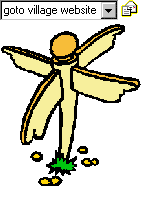
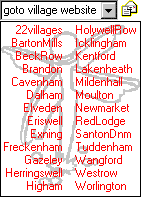
| |
The Bird Life of Santon Downham
The bird life of any area is largely determined by the habitats available.
The first impression of Santon Downham and its immediate surroundings is that of
a small village in the middle of forestry plantations. To some extent, this is
true, but a quick walk around soon reveals more than just wall-to-wall conifers.
Dense, blanket plantations of conifers do not offer much for wildlife, but
Thetford Forest has been sympathetically managed for many decades and now
provides a rich variety of habitats, that in turn, supports a surprising number
of bird species.
We will first look at the types of areas (the habitats) and the birds that
are attracted to Santon Downham, and then look in greater detail at some of the
more important species of our region.
The Habitats
Breckland
Santon Downham is situated in a region known as
Breckland. This term, breckland, is also used to describe the habitat, being
primarily sandy heathland, an important, but much-threatened habitat. One fifth
of Breckland has now been covered with forest. In the 1920s, planting of confers
began, to produce what we now know as Thetford Forest. This replaced the open,
desolate heaths with tree cover.
Coniferous Forest
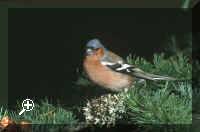 The forest is a standing crop, and grows from
seedlings to large trees which are then harvested at maturity. This means that
even the plantations are ever changing. There are still parts of the forest that
have been densely planted with confers, offering little to birds other than
cover and limited food. Coal Tits, Chaffinches and maybe Goldcrests can be found
in such areas, together with Song Thrushes, Turtle Doves and Golden Pheasant.
The last example, Golden Pheasant, has declined in numbers, and is an introduced
and naturalised breeding bird. Much of the tree planting has been more open,
allowing limited under-storey vegetation. These areas support a wider range of
birds that utilise the trees for food, cover and nest-sites. Here, as well as
the species already mentioned, we may find Great Tits, Blue Tits, Wrens, Robins
and some more specialised forest birds such as Crossbills, Siskins, Tawny Owls,
Redstarts, Long-eared Owls and Goshawk. The forest is a standing crop, and grows from
seedlings to large trees which are then harvested at maturity. This means that
even the plantations are ever changing. There are still parts of the forest that
have been densely planted with confers, offering little to birds other than
cover and limited food. Coal Tits, Chaffinches and maybe Goldcrests can be found
in such areas, together with Song Thrushes, Turtle Doves and Golden Pheasant.
The last example, Golden Pheasant, has declined in numbers, and is an introduced
and naturalised breeding bird. Much of the tree planting has been more open,
allowing limited under-storey vegetation. These areas support a wider range of
birds that utilise the trees for food, cover and nest-sites. Here, as well as
the species already mentioned, we may find Great Tits, Blue Tits, Wrens, Robins
and some more specialised forest birds such as Crossbills, Siskins, Tawny Owls,
Redstarts, Long-eared Owls and Goshawk.
Mixed Forest
Most blocks of trees are more than just one or two species of
conifer. Planting has aimed to provide variety that is visually more pleasing as
well as providing a wider range of tree species. So most areas these days have
bands of deciduous trees along the edge of the pine blocks, or moderate groups
in corners of the plantations. Oak has been widely used in this planting and
together with silver birch, sweet chestnut and some beech, provides new sources
of food and nest sites for a wider range of species of birds. Oak trees support
a huge number of insects on their developing leaves and fruits, and the
caterpillar crop is of great importance to many bird species. The presence of
these deciduous trees encourages the presence of woodpeckers, Nuthatches,
Treecreepers and summer visitors such as Willow Warblers and Chiffchaffs. Ground
nesting Woodcocks are also present, but usually only seen flying at dusk.
Clearings
As the pine trees mature, they are cropped. At present, the forest
is well into its first harvest. When the trees are removed, clearings are
produced which creates a very important new, but transitional habitat. Such
areas have been treated in one of several ways during forest operations, each
providing a subtly different range of conditions for invading plants. Areas
may be scraped clean, stumps left in situ, or piled into long ridges. Such areas
are re-planted very quickly, although throughout the forest, small cleared areas
have been left, specifically for wildlife. A variety of herbaceous plants soon
colonises such areas providing food from seeds or associated insects. This in
turn attracts a different range of birds, either foraging for food or nesting on
the ground. Yellowhammers can be found in such areas, calling out their
characteristic chant of "a little bit of bread and no cheeeeeese" and
Skylark display and breed. Summer visiting Tree Pipits may be found around the
edge of such clearings, provided there are some 'singing posts' in the form of
small trees present.
These new clearings have proved very important in particular for two
once-declining species, Woodlarks and Nightjars, both of which move rapidly into
newly cleared areas to nest on the ground among the newly planted trees.
Populations of both species are now increasing in the Thetford Forest area.
Other
Forest Habitats Scattered throughout the forest and along the roads,
tracks and railway lines are patches of other habitat, where a wider variety of
shrubs and small trees such as gorse, broom, elder and hawthorn may be found. In
other areas, these patches may have only very low vegetation, often together
with heather (ling). This diversifies the forest habitats considerably and a
wide range of birds may be found in such areas. Chaffinches, Dunnocks,
Blackbirds and many others may be encountered in this patchy habitat. Even
Stonechats have returned to occupy a few heath-like areas.
Rivers and Wet Areas
The forest is bisected by the river, the Little Ouse. As
well as the river itself, this produces a marked change in the nearby landscape
and vegetation, all good for some bird species. The river and its banks are home
to Kingfishers, often seen only as a flashing blue jewel flying past. Grey
Wagtails may be found near the various bridges, Swans, Canada Geese, Coots and
Moorhens feed on the river and nest on the banks.
There are a few open ponds between the river and the railway line, west of
the village. These and the associated wet reed and sedge areas support ducks
such as Teal and other birds such as Water Rail.
Alongside the river, there is a variety of wet habitats, many falling within
the Forest Reserve, which flanks the river and is managed for its wildlife.
Bands 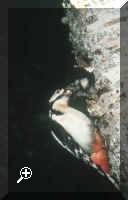 of poplars, marshy ground, areas of reedbed, alder trees and open water
are all present. Willow Tits can be found in the aging poplars together with all
three species of woodpecker, Green, Great Spotted and Lesser Spotted. There is
limited understorey shrub growth in these areas, but there is usually a
considerable amount of annual plants. These provide nesting cover for numerous
ground nesting birds, including many summer visiting warblers such as
Whitethroats and Garden Warblers. In scrubby areas, the unmistakable call of the
Nightingale can be heard, while Grasshopper Warblers sound like revolving
fishing reels in marshy areas. of poplars, marshy ground, areas of reedbed, alder trees and open water
are all present. Willow Tits can be found in the aging poplars together with all
three species of woodpecker, Green, Great Spotted and Lesser Spotted. There is
limited understorey shrub growth in these areas, but there is usually a
considerable amount of annual plants. These provide nesting cover for numerous
ground nesting birds, including many summer visiting warblers such as
Whitethroats and Garden Warblers. In scrubby areas, the unmistakable call of the
Nightingale can be heard, while Grasshopper Warblers sound like revolving
fishing reels in marshy areas.
Just north of the river and west of the road bridge in Santon Downham,
excessive growth of poplars and neglect of some field areas had resulted in
deterioration of existing habitats. Recently, a large area has had the poplars
removed and the water table raised to produce a patch of reedbed. Cattle have
been put on the field area to graze down the rough grass and allow a more
diverse range of plants to move in. Both of these will bring birds back to this
immediate area, including Reed and Sedge Warbler and possibly breeding waders.
House and Garden
There are then, other easily overlooked but important
habitats for birds in and around the village. The houses and their gardens
provide food, shelter and nest sites for a range of species. A garden pond can
provide drinking water, which will attract many birds, especially Crossbills if
you are lucky. A well-stocked pond can also serve to supplement the diet of
Herons (perhaps not considered so lucky by the owners!). Some of the gardens
have preserved older trees, including some of the cherry trees from the Downham
Estate. These will produce ripening cherry flesh for thrushes and Blackbirds,
but more excitingly, the stones for Hawfinches, birds that are well-adapted to
breaking into these seeds with their oversized bills.
Many residents put out food to attract birds to their gardens. Santon Downham
is an ideal place to do this, as the woodland on the doorstep is a huge
reservoir of birds. Roving flocks will soon find food in feeders, be it mixed
seed, sunflower seed or peanuts, as well as being attracted to other foods
thrown out for them. This large density of garden birds in turn attracts
Sparrowhawks. This species was close to extinction in the 1950s in many parts of
the country as a result of the widespread use of certain pesticides. The
population has largely recovered and readily passes through gardens in search of
prey.
The houses themselves provide several species with roost and nest sites. Each
year, summer-visiting House Martins nest under the eaves of old and new
properties in the village. Older houses, with access to soffit space above the
eves, or older style roof tiles may have roosting and nesting Starlings taking
up occupancy, or more excitingly, Swifts. Swifts are fairly site faithful, and
will return year after year. As properties are modernised and tidied up, such
nest sites gradually disappear.
Some important birds of the Santon Downham region
 | Red-backed Shrike
 | 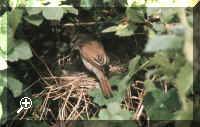 This beautiful member of the shrikes, sometimes called 'butcher birds'
because of their habit of using thorns on shrubs to hang their prey
(large insects, small reptiles and mammals) is one of the sad stories of
Santon Downham. During the breeding season, there used to be numerous
pairs in and around the area, occupying any habitat where there was a
scattering of thorny bushes. This beautiful member of the shrikes, sometimes called 'butcher birds'
because of their habit of using thorns on shrubs to hang their prey
(large insects, small reptiles and mammals) is one of the sad stories of
Santon Downham. During the breeding season, there used to be numerous
pairs in and around the area, occupying any habitat where there was a
scattering of thorny bushes. |
 | The national population had been declining for over a century, and was
about 300 pairs by the early 1950s. Santon Downham was still a place to
visit to ensure seeing one. By the early 1970s, this population had
fallen to 50 pairs and the last pair in the UK bred at St Helen's picnic
site in 1988. A loan male returned in 1989 and called forlornly for a
mate, without success. Since then, there have been one or two pairs
returned to the UK, but not to our region. But keep your eyes open, the
habitat is still there. |
|
 | Siskin
 | This delightful, small finch is a marked contrast to the Red-backed
Shrike, showing a tremendous expansion in breeding areas and numbers of
birds.
The bill of this green, yellow and black bird is very sharp and narrow
for a finch, well adapted for removing pine seeds from cones. It is the
increase in mature forest that has led to the spread and increase in
numbers of breeding birds.
During the breeding season, they can be fairly difficult to see, but it
is during the winter that they become very apparent. There are two
reasons for this. Firstly, the UK breeding population is enhanced by an
influx of birds from the continent, moving to warmer climes during the
colder season. Even UK birds move southwards, and our own local
populations are enlarged by birds from northern England and Scotland. At
this time of year, the birds move around in large feeding flocks and are
very noticeable, if only from their 'buzzy' calls. As well as pine
seeds, they will be found feeding on silver birch and alder seeds. The
second reason for their being easy to see in winter is that in the early
1960s, they discovered peanuts hung out for birds in gardens. This has
since become an important food for them when natural foods are scarce.
They can be attracted to gardens very easily throughout the winter
months by putting out some peanuts, especially in one of the red,
plastic mesh bags. By early March, the birds are getting ready to return
to their breeding grounds in the UK or on the continent, and need high
energy foods for the journey. Fat-rich peanuts act as an excellent
supplement, and large numbers of birds move through garden areas,
feeding up. The peak in numbers in gardens is usually during the second
half of March, but if there is plenty of natural food, numbers requiring
the supplementary diet will be less. It is always difficult to tell how
many birds may be using your garden as a food source, as individuals
look the same. Studies with ringed birds has shown the several hundred
different Siskins may be using the average garden in Santon Downham
during the last two weeks of March, even though there may only be two to
three at any one time.
Because we have our own breeding population in the forest, Siskins can
be seen every month of the year. |
|
 | Crossbill
 | Crossbills are robust finches whose population goes rapidly up and
down according to how much food is available in the form of pine cones.
In a good cropping year, numbers are enhanced by wanderers from the
continent.
Considering that this finch is one of our larger ones, and that the male
is a bright orange-red and the female yellow-green, they are
surprisingly difficult to see in the forest, as much time is spent high
in the canopy. Flocks can frequently be seen flying over at moderate
heights, but unless you are familiar with their call, they will go
unnoticed. One way of improving your chances is to have a garden pond
with a shelving end and small branches to encourage perching that will
bring in flocks to drink.
The name Crossbill is a literal description. The upper and lower
mandible cross at the tip, an adaptation for removing conifer seeds from
cones, at which they are the experts. As this is almost their only food
source, they are dependent on mature conifers and good crops of cones.
They are present all year, but the fluctuating population and the
difficulty in seeing them means they are often overlooked. |
|
 | Nightjar
 | 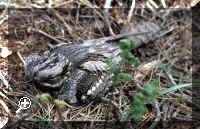 This has to be one of the more exciting birds of our area as well as
being one of the species to benefit from the forest management.
Nightjars are summer visitors, arriving in May to breed. They occupy
forest clearings, where they nest on the ground, making only a shallow
depression for their eggs. As soon as they return from their wintering
grounds to the south, the males will establish territory. As dusk falls,
they start their territorial churring, a fascinating noise that is very
un-birdlike. This is usually issued from a 'singing post', often a tall
tree on the edge of their territory, and the sound made more eerie as
the bird twists its head slowly from side to side. This has to be one of the more exciting birds of our area as well as
being one of the species to benefit from the forest management.
Nightjars are summer visitors, arriving in May to breed. They occupy
forest clearings, where they nest on the ground, making only a shallow
depression for their eggs. As soon as they return from their wintering
grounds to the south, the males will establish territory. As dusk falls,
they start their territorial churring, a fascinating noise that is very
un-birdlike. This is usually issued from a 'singing post', often a tall
tree on the edge of their territory, and the sound made more eerie as
the bird twists its head slowly from side to side.
All activity takes place during the evening and night, the birds
remaining motionless on the ground during the hours of daylight, relying
on their cryptic colouration to render them undetectable. They feed on
moths and other flying insects, catching them in their large gaping
mouths. As a male defends its territory, it will fly around a series of
singing posts, interrupting its churring with a strange whistle and some
wing clapping.
Because of their behaviour, most people are probably completely unaware
of the presence of Nightjars. They return each year, to go through the
whole breeding cycle, and then fly back to warmer climes over the winter
period. Dog-walkers probably pass within a few metres of day-roosting
birds, without noticing them.
The preferred habitat of Nightjars has been open heathland, a
much-threatened habitat. As the habitat disappeared, this species
declined markedly in numbers. Then, as felling started in coniferous
forests such as Thetford, new and suitable clearings appeared. When such
areas are re-planted, Nightjars will continue to breed amongst the
growing trees provided the gaps between remain clear enough for
take-off. Nightjars move in to newly cleared areas very quickly, setting
up territory during the first breeding season that such areas appear.
The Thetford Forest population of Nightjars continues to increase and is
very healthy. |
|
 | Woodlark
 | 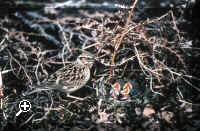 This is another of the region's special birds. Woodlarks were never
common in the UK, but their numbers decreased during the 20th century to
as few as 100 pairs in the early 1960s. In the 1970s, birdwatchers used
to come to Thetford Forest area specifically to see this diminutive,
brown bird, where it was fairly easily found. This is another of the region's special birds. Woodlarks were never
common in the UK, but their numbers decreased during the 20th century to
as few as 100 pairs in the early 1960s. In the 1970s, birdwatchers used
to come to Thetford Forest area specifically to see this diminutive,
brown bird, where it was fairly easily found.
Even before spring is in the air, Woodlarks begin their display, rising
high in the air above clearings, issuing a beautiful series of fluty
descending phrases, seemingly going on for ever as they drift higher and
higher. The rest of their life is spent without drawing attention to
themselves, moving around a lot on the ground, where they also build
their nests.
Like the Nightjar, Woodlarks have taken to the habitat produced by tree
felling in the forest. They quickly colonise newly cleared areas and are
soon present at densities greater than that of Nightjars. Ron Hoblyn,
who used to work for the Forestry Commission, now Forest Enterprise, has
studied Woodlarks for many years and continues to do so. He has seen the
rise in population of Woodlarks, as well as having been instrumental in
some on the conservation practices that have helped this special bird.
In 2000, there were over 50 pairs in and around Santon Downham alone. |
|
 | Woodcock
 | This is another species that is well represented in and around Santon
Downham, but easily overlooked because of its behaviour. It is in fact a
representative of the group of birds called waders, most of which will
be found on coasts and estuaries, feeding on invertebrates in the mud.
The Woodcock is an exception, being only found on the coast or near
estuaries when they migrate - and then it is usually continental birds
flying to the UK for winter, as our own population is resident
throughout the year.
Woodcocks breed and feed in woodland, not in clearings. They prefer
moist, not too dense woodlands, the tree composition being of lesser
importance. Being mainly crepuscular (active at dusk) and incredibly
well camouflaged it is unlikely that you will come across them on the
ground during the day. They have been a 'game' bird for centuries, and
old maps show that the small patch of woodland behind and downhill from
the village hall was called Woodcock Covert, reflecting its use for
breeding birds to shoot on the old estate.
If they are extremely difficult to see on the ground or during the day,
they can be easily seen when they fly in the late evening. Their display
involves a territorial flight, referred to as roding, around a large
area, often over clearings, when their peculiar grunt and whistle call
draws attention to their presence. They flap slowly around a circuit on
broad, rounded wings, with their long bills pointing down at an angle.
Any time from early spring through to late summer can reveal roding
birds, but still, clear evenings in May, June and July are best. Just
occasionally, you might see one in an unusual situation. I have seen
them sitting on the road near the village green on more than one
occasion. |
|
So, far from being a boring habitat without a great variety of species,
Santon Downham and its surroundings offers aesthetically pleasing areas rich in
wildlife. From my own garden on the edge of the village, I have seen or heard
almost 80 species of birds within the three and a half years that I have lived
there.
Keep you ears and eyes alert and you never know what birds you might see.
Many thanks to Ron Hoblyn for commenting on and adding to this manuscript.
(Ron has lived in the village for 30 years - his seen and heard bird list from
his garden is 133!)
Dr Derek Toomer, Membership Development Officer, British Trust for
Ornithology Thetford, Norfolk. October 2000C
|